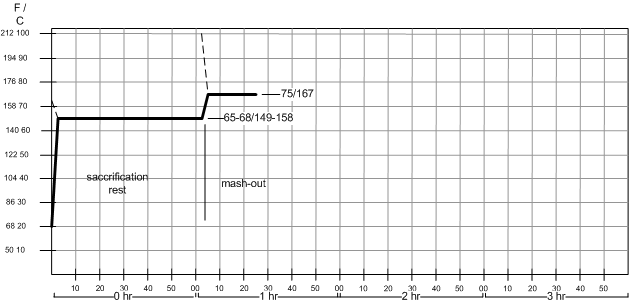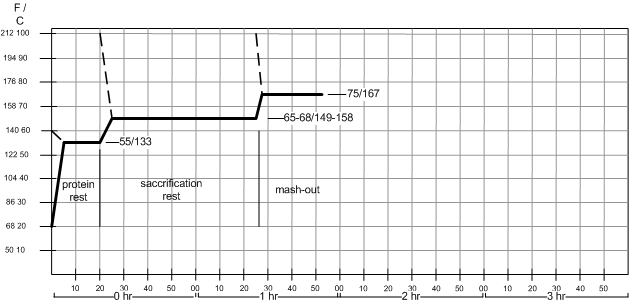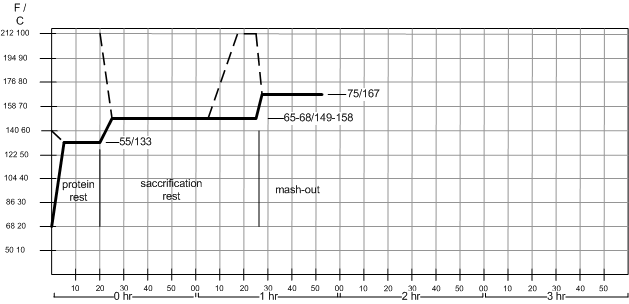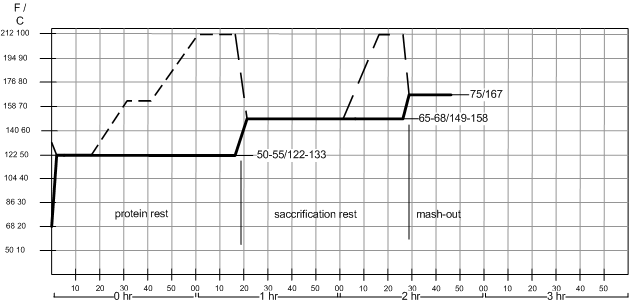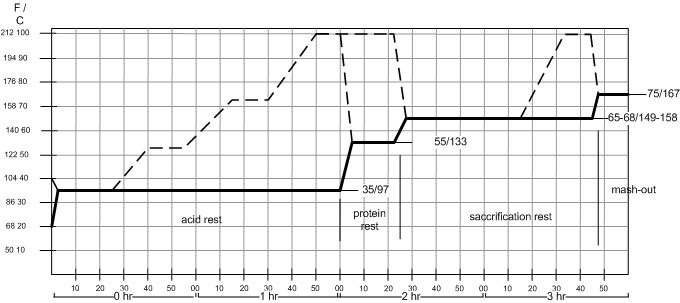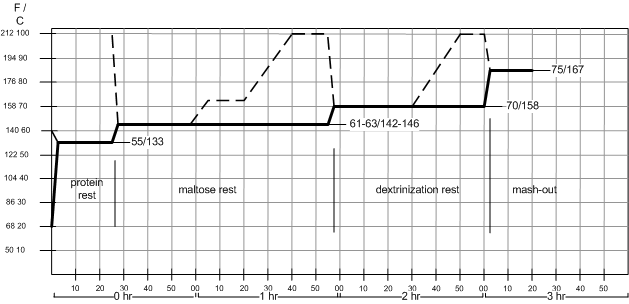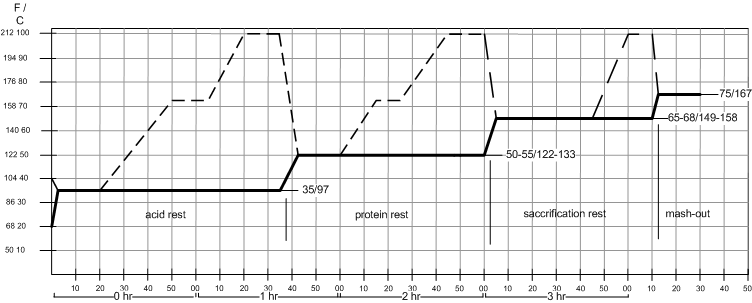| Line 1: | Line 1: | ||
| − | + | [[Category:Methodology]] | |
| − | + | [[Category:Beer]] | |
This article tries to explain the various mashing procedures that are of interest to the home brewer. Mashing procedures are basically the application of the [[Theory of Mashing]] by mixing the grain with water (mash) and resting this mash at a single or multiple temperatures to activate enzymatic activity which converts the grain solids into wort soluble compounds. | This article tries to explain the various mashing procedures that are of interest to the home brewer. Mashing procedures are basically the application of the [[Theory of Mashing]] by mixing the grain with water (mash) and resting this mash at a single or multiple temperatures to activate enzymatic activity which converts the grain solids into wort soluble compounds. | ||
| Line 32: | Line 32: | ||
:''Note: Plamer writes that R can be expressed as quarts per pound or litres per kilogram. This is not correct since 1 l/kg is approximately 0.5 qt/lb. This needs to be accounted for when using metric units in the above formula. The temperature however can be used as Fahrenheit or Celsius as long as all temperature values use the same unit or measure.'' | :''Note: Plamer writes that R can be expressed as quarts per pound or litres per kilogram. This is not correct since 1 l/kg is approximately 0.5 qt/lb. This needs to be accounted for when using metric units in the above formula. The temperature however can be used as Fahrenheit or Celsius as long as all temperature values use the same unit or measure.'' | ||
| − | Hitting the mash temperature is for many brewers their biggest problem when doing a single infusion mash. This can | + | Hitting the mash temperature is for many brewers their biggest problem when doing a single infusion mash. This can some times lead to frustration. The reason for that is, that the above formula doesn't account for heat loss to the mash tun. It basically assumes that the mash tun has a thermal capacity of 0. To get around this one can preheat the mash tun with some boiling water or adjust the strike water temperature based on the results in previous mashes. If the latter is used the brewer should keep the mash tun and grain temperature constant between the different mashes. |
Another option of precisely hitting the mash temperature is to keep hot and cold water at hand and infuse about 80% of the strike water into the mash. The stir well to even out the mash temperature and measure the mash temperature. Now use hot and cold water infusions to get the mash to the desired mash temperature. This works well for thinner mashes and round mash tuns as the mash is easier to stir in them which is necessary to get a precise mash temp reading between the infusions. | Another option of precisely hitting the mash temperature is to keep hot and cold water at hand and infuse about 80% of the strike water into the mash. The stir well to even out the mash temperature and measure the mash temperature. Now use hot and cold water infusions to get the mash to the desired mash temperature. This works well for thinner mashes and round mash tuns as the mash is easier to stir in them which is necessary to get a precise mash temp reading between the infusions. | ||
Revision as of 08:16, 25 March 2007
This article tries to explain the various mashing procedures that are of interest to the home brewer. Mashing procedures are basically the application of the Theory of Mashing by mixing the grain with water (mash) and resting this mash at a single or multiple temperatures to activate enzymatic activity which converts the grain solids into wort soluble compounds.
Which mash schedule to choose
This question comes up quite frequently in the form of "What benefit do I get from using a more complicated mash schedule than single temperature infusion?".
Mashing needs to be seen as an extension of the malting process and what wasn't done during the malting of the grain, needs to be done during mashing. And the more modified a malt is, the less mashing steps are necessary to produce a wort suitable for brewing a quality beer. Even worse, by selecting a more intense mashing schedule for a highly modified malt certain steps, like protein conversion, can be overdone and lead to a less optimal wort composition.
Here is a list of some malts showing mashing schedules that work well for them:
- American or British 2-row (Pale malts): single infusion mash
- Durst TurboPils: single infusion mash
- Durst Pilsner: single infusion or 2 step infusion
- Briess Pilsen: 2 step infusion / decoction mash
- Weyermann Pilsner: 2 step infusion
- home malted malt: multi step infusion / deoction mash
Single temperature infusion mash
The single infusion mash uses a single temperature rest at which the beta and alpha amylase enzymes are active to convert the malt starches into wort sugars. The higher the mash temperature is, the lower the limit of attenuation of the resulting wort will be. This is the most common mash schedule among home brewers and craft brewers because it is well suited for American and British 2-row malts which are generally highly modified and don't benefit from a lower temperature rests. It is also well suited for the use of unheated mash tuns (e.g. coolers) which are the preferred mash vessel among most home brewers. The rest temperatures are commonly between 149 *F (65 *C) and 165 *F (69 *C). Many brewers like to use 154 *F (67.5*C) as their preferred mash temp as it gives a nice balance of body and fermentability that works well for British and American style ales.
In order to do a single infusion mash, the strike water (water used for the mash) is heated to a certain temperature such that when the grains are mixed in, the resulting temperature is the desired rest temperature. The temperature of the strike water can be calculated with the following formula [Palmer, 2006]:
Strike Water Temperature Tw = (.2/R)(T2 - T1) + T2
- R = Ratio of water to grain in quarts per pound
- T1 = the temperature of the grains in Fahrenheit (or Celsius)
- T2 = the target temperature of the mash in Fahrenheit (or Celsius)
- Note: Plamer writes that R can be expressed as quarts per pound or litres per kilogram. This is not correct since 1 l/kg is approximately 0.5 qt/lb. This needs to be accounted for when using metric units in the above formula. The temperature however can be used as Fahrenheit or Celsius as long as all temperature values use the same unit or measure.
Hitting the mash temperature is for many brewers their biggest problem when doing a single infusion mash. This can some times lead to frustration. The reason for that is, that the above formula doesn't account for heat loss to the mash tun. It basically assumes that the mash tun has a thermal capacity of 0. To get around this one can preheat the mash tun with some boiling water or adjust the strike water temperature based on the results in previous mashes. If the latter is used the brewer should keep the mash tun and grain temperature constant between the different mashes.
Another option of precisely hitting the mash temperature is to keep hot and cold water at hand and infuse about 80% of the strike water into the mash. The stir well to even out the mash temperature and measure the mash temperature. Now use hot and cold water infusions to get the mash to the desired mash temperature. This works well for thinner mashes and round mash tuns as the mash is easier to stir in them which is necessary to get a precise mash temp reading between the infusions.
With today's highly modified and thus enzymatic strong malts, the mash is generally converted after 15-30 min based on the rest temperature. Lower temperatures mashes convert slower than higher temp mashes of the same grist (see The Theory of Mashing for further details). Most brewers do however mash 60-90 minutes to ensure complete conversion and for the time it gives them to heat the sparge water for example. It is always a good practice to check for conversion of the mash with an iodine test.
To do an iodine test you need a white plate, small spoon and iodine/starch test solution (some home brew stores sell iodine test strips, but they are for testing an iodine solution not for testing for starch). Stir the mash a part ofd the mash a little and take a small sample onto the plate with the spoon. Now drip a few drops of iodine solutions onto that sample. If there are still unconverted starches in the mash, the sample will turn black or dark purple. The mash is converted when you don't see that happening. At this point the wort should also taste sweet. Discard the sample as iodine is toxic.
Though this is considered a single temperature step mash, a mash-out rest can be added. Using hot water infusions (or even decoction as shown later) the mash temperature is raised to 167 *F (75 *C). No harm is done if that temperature is not reached exactly. It should however not be exceeded. Many brewers believe that the purpose of this rest is to stop the enzymatic activity, but that is usually not the case as the alpha amylase is not fully deactivated until 176 *F (80 *C). The prupose of the mash-out is to aid lautering as hotter wort will flow more easily while still allowing enzymatic activity to convert any starches that might be unlocked during lautering [Narziss, 2005]. While this is of a lesser concern for the homebrewer, a mash-out is still a good practice.

